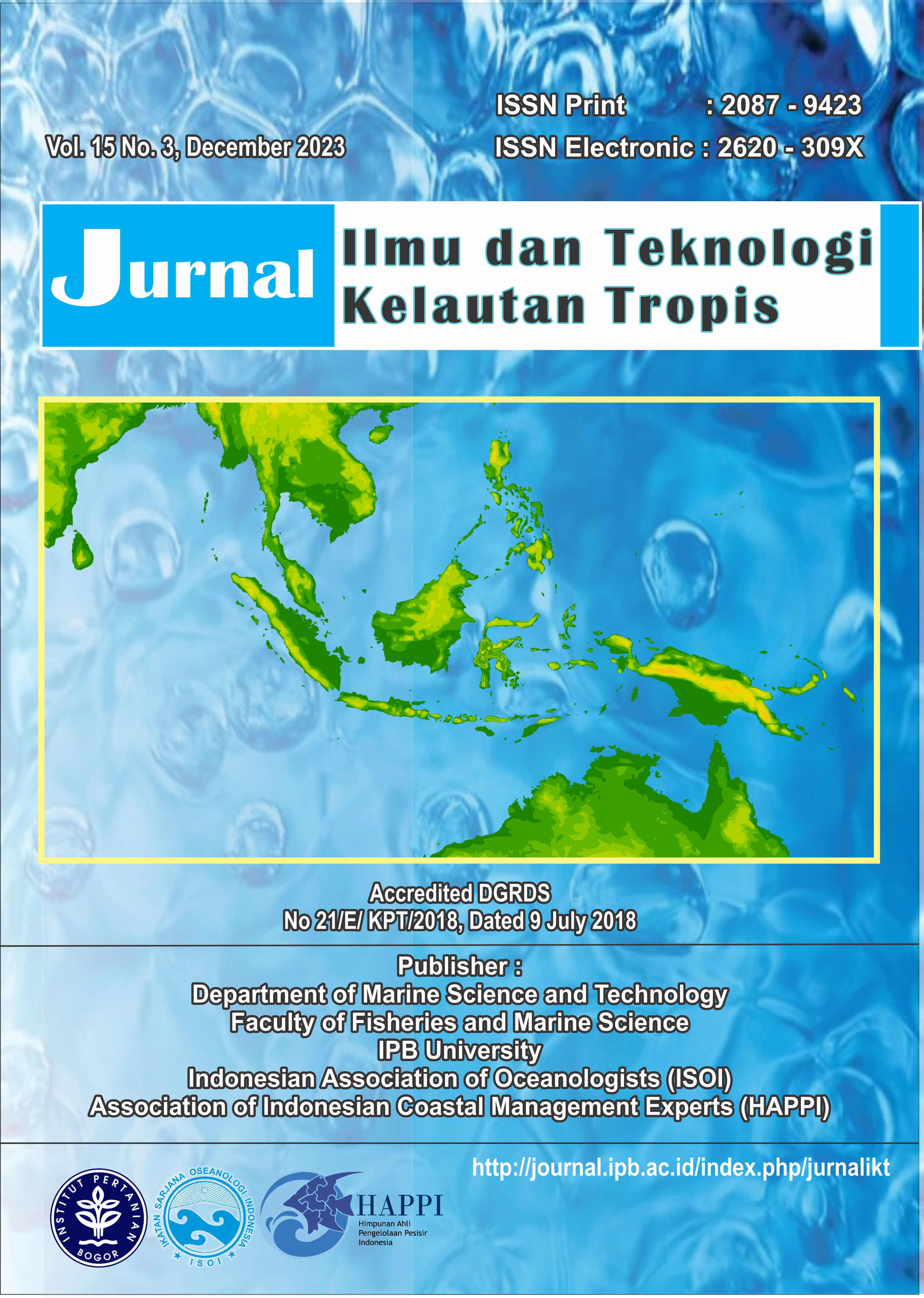SEA SURFACE TEMPERATURE DISTRIBUTION IN LAMPUNG BAY BASED ON LANDSAT-8 IMAGES AND ITS RELATION TO THE INDIAN OCEAN DIPOLE (IOD) ON THE PERIOD YEAR 2013-2021
Abstract
Sea surface temperature is an important oceanographic attribute in ocean waters, that changes of sea water temperature can change aquatic ecosystems. Lampung Bay waters originating from the Indian Ocean and the Java Sea which pass through the Sunda Strait will be influenced by the Indian Ocean Dipole (IOD). This study aims to analyze spatial and temporal inter-annual Sea Surface Temperature (SST) distribution patterns in the last 9 years (2013-2021) and analyze the Indian Ocean Dipole (IOD) phenomenon that caused an anomaly of SST in Lampung Bay. The method used in this study is a regression validation method, descriptive method and correlative statistics. The results showed that the SST value of Landsat-8 image extraction can represent in situ SST conditions because R2=0.6872. The IOD phenomenon influences the Lampung Bay water’s SST distribution pattern. Positive IOD phase years (2015, 2018 and 2019) or negative IOD phases (2013 and 2016) shown SST of Lampung Bay waters has a different distribution pattern and anomalous values. But correlation between IOD and SST in Lampung Bay had two different result which in open water (TL3, TL4, and TL5) is mid-correlate (r>0.7) and weak correlation (r<0.2) at observation points TL1 and TL6 which are close to the mainland.
Downloads
References
Arief, M., S.W. Adawiah, E. Parwati, R. Hamzah, & T. Prayogo. 2015. Pengembangan model ekstraksi suhu permukaan laut menggunakan data satelit landsat 8 (Studi Kasus Teluk Lampung). Jurnal Penginderaan Jauh, 12(2): 107–122. https://jurnal.lapan.go.id/index.php/jurnal_inderaja/article/view/2391
Cahyono, A.B., H.D. Armono & D. Saptarini. 2017. Estimation of Sea Surface Temperature (SST) Using Split Window Methods for Monitoring Industrial Activity in Coastal Area, (January). Applied Mechanics and Materials, 862: 90-95. http://dx.doi.org/10.4028/www.scientific.net/AMM.862.90
Dimijultyo, G. 2021. Pemetaan suhu permukaan laut perairan Teluk Lampung, Provinsi Lampung Menggunakan Citra Satelit Landsat 8 [Skripsi]. Palembang: Universitas Sriwijaya.
Environment Protection Agency (EPA). 2016. Climate Change Indicators in the United States: Sea Surface Temperature [Online] Diakses Pada: 19 Juni 2023, Pukul 19:20 WIB. Tersedia: https://www.epa.gov/sites/default/files/2016.
Hasan, I. 2003. Analisis Data Penelitian Dengan Statistik. Jakarta (Id): Bumi Aksara.
Hasanah, M. 2023. Pemodelan Gelombang Di Perairan Teluk Lampung [Skripsi]. Bandar Lampung: Universitas Lampung.
Jaelani, L.M., R. Limhuwey, N. Kurniadin, A. Pamungkas, E.S. Koenhardono, & A. Sulisetyono. 2016. Estimation of Total Suspended Sediment and Chlorophyll-A Concentration from Landsat 9-Oli: The effect of atmosphere and retrieval algorithm. The Journal for Technology and Science, 27(1): 16-23. http://dx.doi.org/10.12962/j20882033.v27i1.1217
Kartikasari F, et al. 2016. Analisis Sebaran Konsentrasi Suhu Permukaan Laut dan Ph Untuk Pembuatan Peta Lokasi Budidaya Kerapu Bebek Menggunakan Citra Satelit Landsat -8 (Studi Kasus: Teluk Lampung, Lampung). Jurnal Teknik ITS, 5(2): 2301-9271.
Kunarso, S. Hadi, N.S. Ningsih, & M.S. Baskoro. 2011. Variabilitas Suhu dan Klorofil-a di Daerah Upwelling pada Variasi Kejadian ENSO dan IOD di Perairan Selatan Jawa sampai Timor. Ilmu Kelautan. 16(3): 171-180. https://doi.org/10.14710/ik.ijms.16.3.171-180
Martono, Halimurrahman, R. Komarudin, Syarif, S. Priyanto, & D. Nugraha. 2008. Studi Variabilitas Lapisan Atas Perairan Samudera Hindia Berbasis Model Laut. LAPAN. Jakarta.
Milasari, A., D.H. Ismunarti, E. Indrayanti, F. Muldiyanto, A. Ismanto, & A. Rifai. 2021. Model Arus Permukaan Teluk Lampung pada Musim Peralihan II dengan Pendekatan Hidrodinamika. Buletin Oseanografi Marina, 3(10), 259–268. https://doi.org/10.14710/buloma.v10i3.38293
Nieblas, A.E., B.M. Sloyan, A.J. Hobday, R. Coleman & A.J. Richardson. 2009. Variability of biological production in low wind-forced regional upwelling systems: a case study off southeastern Australia. Limnology and Oceanography, 54: 1548-1558. https://doi.org/10.4319/lo.2009.54.5.1548
Ostrander GK, KM Armstrong, ET Knobbe, D Gerace, and EP Scully. 2000. Rapid transition in the structure of a coral reef community: The effects of coral bleaching and physical disturbance. P.Natl. Acad. Sci. USA, 97(10): 5297–5302. https://doi.org/10.1073/pnas.090104897
Putra, I.N.J.T., I W. G.A. Karang, I.D.N.N. Putra. 2019. Analisis temporal suhu permukaan laut di perairan Indonesia selama 32 tahun (Era AVHRR). Journal of Marine and Aquatic Science, 5(2): 234-246. https://doi.org/10.24843/jmas.2019.v05.i02.p11
Saji, N.H., B.N Goswami, P.N. Vinayachandran & T. Yamagata. 1999. A dipole mode in the tropical Indian Ocean. Nature. 401: 360-363. https://www.nature.com/articles/43854
Sarawasta, A.G., P. Subardjo & Muslim. 2013. Pengaruh Monsun terhadap Distribusi Suhu Permukaan Laut dan Klorofil-A di Perairan Selatan Bali. Jurnal Oseanografi., 2(1): 79-87. https://ejournal3.undip.ac.id/index.php/joce/article/view/4524
Syariz, M.A., L.M. Jaelani, L. Subehi, A. Pamungkas, E.S. Koenhardono & Sulistyono. 2015. Retrieval of Sea Surface Temperature Over Poteran Island Water of Indonesia with Landsat 8 Tirs Image: A Preliminary Algorithm. The International Archives of The Photogrammetry, Remote Sensing and Spatial Information Sciences Xl-2/W4 (October).
Tugiyono, Diantari R, Efti. 2015. Kajian Kualitas Air Pesisir Teluk Lampung. Prosiding Semirata 2015. 292-299.
Vinayachandran, P.N., P.A. Francis & Rao. 2010. Indian Ocean dipole: processes and impacts. Current Trends in Science, N. Mukunda (ed), Indian Academy of Sciences, Bangalore, 2009 (in press).
Webster, P.J.; A.M. Moore, J.P. Loschnigg, & R.P. Leben. 1999. Coupled ocean–atmosphere dynamics in the Indian Ocean during 1997–98. Letters to Nature, 401(6751): 356–360. http://dx.doi.org/10.1038/43848
Widhi, B.K. 2012. Kajian Pola Arus di Perairan Teluk Lampung Menggunakan Pendekatan Model Hidrodinamika 2-Dimensi Delft3d. Journal of Oceanography. 01(2): 169-177. https://ejournal3.undip.ac.id/index.php/joce/article/view/4157
Witasari, Yunia & Wenno. 2000. Pola Sebaran Pumis di Sedimen Dasar Teluk Lampung, Kaitannya dengan Arah dan Kecepatan Arus Pasang Surut, Lampung. LIPI. Jakarta.
Copyright (c) 2023 Jurnal Ilmu dan Teknologi Kelautan Tropis

This work is licensed under a Creative Commons Attribution-ShareAlike 4.0 International License.
The author submitting the manuscript must understand and agree that the copyright of the article manuscript must be submitted/transferred to the Jurnal Ilmu dan Teknologi Kelautan Tropis. This work is licensed under the Creative Commons Attribution-ShareAlike 4.0 (CC BY-SA) International License in which the Author and Reader can copy and redistribute the material in any media or format, and remix, modify and build material for any purpose, but they must provide appropriate credit (citing articles or content), provide a link to the license, and indicate whether there is a change. If you mix, change, or create material, you must distribute your contribution under the same license as the original.



.png)














